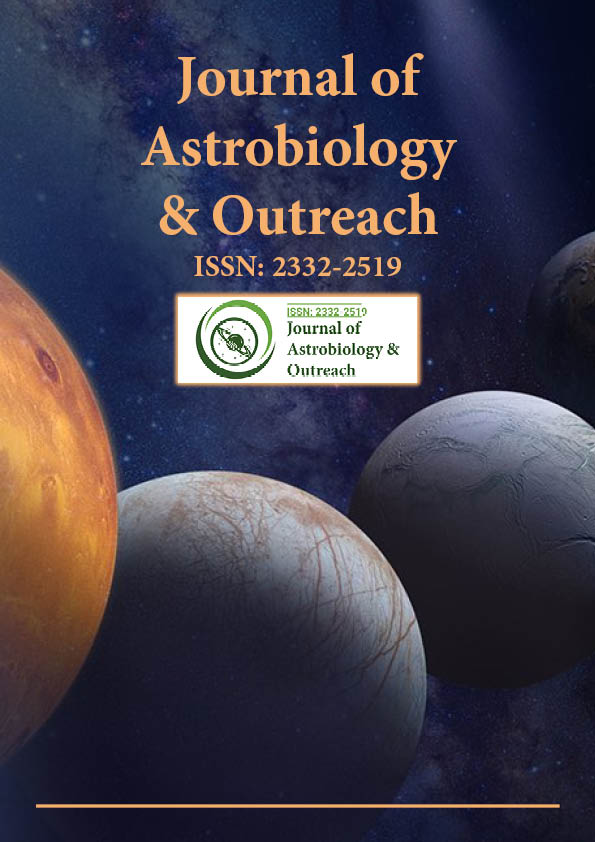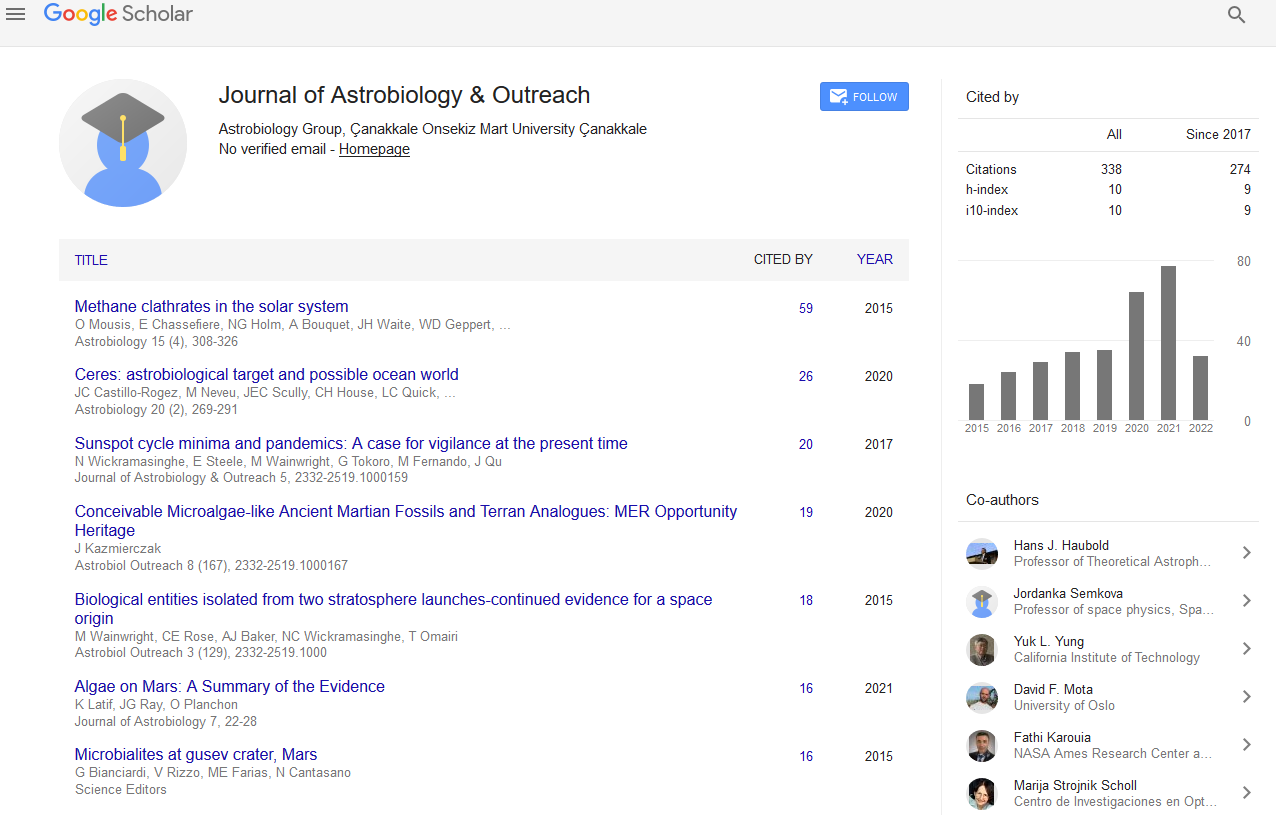Indexed In
- Open J Gate
- Academic Keys
- JournalTOCs
- RefSeek
- Hamdard University
- EBSCO A-Z
- OCLC- WorldCat
- Google Scholar
Useful Links
Share This Page
Journal Flyer

Open Access Journals
- Agri and Aquaculture
- Biochemistry
- Bioinformatics & Systems Biology
- Business & Management
- Chemistry
- Clinical Sciences
- Engineering
- Food & Nutrition
- General Science
- Genetics & Molecular Biology
- Immunology & Microbiology
- Medical Sciences
- Neuroscience & Psychology
- Nursing & Health Care
- Pharmaceutical Sciences
Commentary - (2024) Volume 13, Issue 2
Rediscovering the Stars with Modern Astronomy Gear in Telescope Renaissance
Elisa Bayan*Received: 16-Dec-2023, Manuscript No. JAO-23-24483; Editor assigned: 19-Dec-2023, Pre QC No. JAO-23-24483; Reviewed: 02-Jan-2025, QC No. JAO-23-24483; Revised: 22-Jan-2025, Manuscript No. JAO-23-24483; Published: 29-Jan-2025, DOI: 10.35248/2332-2519.25.13.380
Descripition
The evolution of telescopes serves as a testament to humanity's relentless pursuit of understanding the cosmos. In the days of Ptolemy and Galileo, astronomers peered into the night sky using rudimentary refracting telescopes. These instruments, while revolutionary in their era, were constrained in their ability to capture the intricacies of celestial bodies. However, the 17th century ushered in a transformative period with the emergence of reflector telescopes. Innovations by luminaries such as Isaac Newton led to the creation of telescopes utilizing mirrors instead of lenses, heralding a new era of enhanced image clarity and reduced chromatic aberrations and reflectors covered the method for a more profound exploration of the universe.
The technological steps in modern astronomy gear are zero short of significant. The advancements is the concept of aperture, the size of which determines the amount of light a telescope can collect. In contemporary telescopes, larger apertures are improving light-gathering capabilities. This augmentation proves significant for observing faint celestial objects, pushing the boundaries of astronomical exploration to unprecedented limits. Furthermore, telescopes today boast computerized mounts and tracking systems that automate the location and tracking of celestial objects, compensating for Earth's rotation. This technological synergy not only enhances the efficiency of observations but also democratizes access to the wonders of the night sky.
Evolution of telescopes
Humanity's fascination with the stars dates back to antiquity. Early astronomers, such as Ptolemy and Galileo, observed the night sky using rudimentary instruments like the refracting telescope. These instruments, although groundbreaking in their time, were limited in their ability to capture the intricate details of celestial bodies.
Technological advances in modern astronomy gear
One of the significant factors in telescope design is the aperture size, which determines the amount of light a telescope can collect. Modern telescopes boast larger apertures, allowing for increased light-gathering capabilities. This enhancement is vital for observing faint celestial objects, pushing the boundaries of astronomical exploration.
Citizen science and community engagement
Advancements in manufacturing processes and materials have made quality telescopes more affordable and accessible to the public. With these powerful instruments, amateur astronomers make significant contributions to the field through citizen science initiatives, increasing the collective understanding of the cosmos. The internet has facilitated global collaboration in astronomy. Online observatories and platforms enable astronomers to share observations, data, and research in real-time. This interconnectedness fosters a sense of community among stargazers worldwide, creating an environment where enthusiasts and professionals collaborate to unravel the mysteries of the cosmos.
A pivotal aspect of the telescope renaissance lies in the integration of imaging technology. High-resolution cameras and advanced sensors now adorn telescopes, capturing awe-inspiring images of distant galaxies, nebulae, and other celestial marvels. The combination of digital imaging and optics has made astrophotography more accessible, enabling amateur astronomers to create images that were previously only possible in professional observatories. The completed product is a rich tapestry of celestial portraits that greatly advance the scientific understanding of the cosmos while also captivating the imagination. Advancements in manufacturing processes and materials have made quality telescopes more affordable and accessible to the public. This democratization has given rise to a vibrant community of amateur astronomers who, armed with powerful instruments, contribute significantly to the field through citizen science projects.
The synergy between professional and amateur astronomers enriches our collective understanding of the universe, fostering a sense of community and shared wonder. The internet has emerged as a catalyst for global collaboration in astronomy. Astronomers can exchange data, research, and observations in real time through online observatories and platforms. Transcending geographical boundaries in the pursuit of unraveling the mysteries of the cosmos. The collective efforts of this global community amplify the impact of individual observations, turning stargazing into a collaborative venture that transcends borders.
Conclusion
Modern telescopes equipped with advanced spectrographs have played a pivotal role in the discovery of exoplanets. By analyzing the light emitted by distant stars, astronomers can identify subtle variations that indicate the presence of orbiting planets. Telescopes have also become indispensable tools in the study of dark matter and dark energy, mysterious components that constitute the majority of the universe. Observations of galaxy clusters, gravitational lensing, and cosmic microwave background radiation contribute to our ongoing quest to comprehend the fundamental forces shaping the cosmos. The recent surge in advancements in modern astronomy equipment has revitalized our enduring interest in the cosmos. As technological strides persist and a growing number of enthusiasts participate in amateur astronomy, the ongoing odyssey of reconnecting with the stars holds the potential of an endlessly thrilling and cooperative venture.
Citation: Bayan E (2025) Rediscovering the Stars with Modern Astronomy Gear in Telescope Renaissance. J Astrobiol Outreach. 13:380.
Copyright: © 2025 Bayan E. This is an open-access article distributed under the terms of the Creative Commons Attribution License, which permits unrestricted use, distribution, and reproduction in any medium, provided the original author and source are credited.

